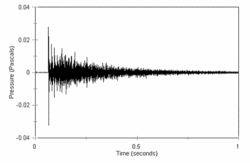
In trying to understand something like “Track,” I find that as a new angle is uncovered I need to make note of it before it slips back into the aether. Part of understanding is explaining something to yourself, and then trying to explain it to someone else. It’s turning a shard of a mental image into a story. Understanding the signal-to-noise ratio in that transmission is one measure of success. Sometimes a transmission can carry the payload of a dense and ambiguous metaphor— something that is neither signal nor noise.
Noise is something we can’t or don’t want to understand. Signal is communication for which we already have a framework for understanding. Ambiguity is a different kind of payload in a signal. Sometimes it’s important to drive toward clarity, other times it’s important to let something remain in an ambiguous state and allow for the meaning of play and play of meaning to unfold. The usefulness of track is something largely undiscovered. The tools we use to track the idea of Track are both primitive and highly sophisticated. We talk to each other; we listen; and then we talk to each other some more.

The small piece of the picture that came into focus for me today was the distinction between “who” and “what.” Distinguishing “track” and “search” seems to have some conceptual value. Search is more associated with what; track is more associated with who. Either can be used for the purposes of the other, but there’s some value in making this distinction.
There’s a sense in which track can be used to understand the current presence status of a person on the Network. We use a status indicator on IM to indicate to our personal network of reciprocal connections our level of availability. Tracking a person or a topic keyword tells you who is currently speaking on the Network. Who, not what. Speaking, through microblogging (tweeting), is a form of indicating your presence and availability.
An essential component of track is its basis in the real-time stream. One way we make conversation is through making sounds– and sounds have a physics. Finding the presence of speakers must occur within the context of the sound envelope— track must do its work in the period starting at the end of the sustain and finishing at the end of the decay.
The decrease in amplitude when a vibrating force has been removed is called decay. The actual time it takes for a sound to diminish to silence is the decay time. How gradual this sound decays is its rate of decay.
Once the sound envelope has completed its decay, the presence of the speaker can no longer be assured.
A directed social graph, or affinity group, can be followed to understand current presence status. Track can also be used for that purpose, and additionally to discover new speakers on the subject of one’s affinity. Condensing value out of that stream returns us to the beginning. A story emerges, a melody emerges– from the attack, sustain and decay– of the voices in the stream. A thousand flowers bloom in an eternal golden braid.
Comments closed






